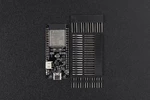








FireBeetle 2 ESP32-E (N16R2) IoT Microcontroller (16M / 2M, Supports Wi-Fi & Bluetooth)
Introduction
The FireBeetle 2 ESP32-E (N16R2) IoT development board equipped with 16M Flash and 2M PSRAM. It is designed to provide superior performance for applications such as the LVGL graphics library for interface design and interaction. Built on the foundation of Espressif's ESP32-WROOM-32E-N16R2 module, it boasts a 32-bit dual-core processor with a clock frequency of up to 240MHz. With support for WiFi and Bluetooth dual-mode communication, it is an ideal choice for IoT scenarios.

Abundant peripheral interfaces
Including 17 digital pins, 11 analog pins, 3 UART interfaces, 1 SPI interface, 1 I2C interface, 1 I2S interface, and 2 DAC interfaces, it can meet various hardware connection needs.

Board Overview of FireBeetle 2 ESP32-E (N16R2) Development Board
Dual power supply modes
Supporting both USB and external 3.7V lithium battery power supply, it can automatically switch between power sources under dual power supply, and supports both USB and external DC charging modes.
Support for multiple programming methods
Including Arduino IDE, ESP-IDF, Micro-Python, etc., catering to different developers' programming habits.

Compact design, convenient for embedding
With a size of only 25.4mm × 60mm, onboard WiFi and Bluetooth antennas, and using stamp hole design, it is convenient to embed or integrate into PCB prototypes.
The difference between ESP32-WROOM-32E and ESP32-WROOM-32UE
The ESP32-WROOM-32E (this product) uses an onboard PCB antenna. This type of antenna is realized through PCB technology, does not require separate antenna assembly, is not easily damaged by touch, and is convenient for whole machine assembly. Onboard antennas can save space, reduce costs, and because they can be carefully positioned on the board, they can provide signal integrity. However, their gain may be lower than that of external antennas.
The ESP32-WROOM-32UE, on the other hand, connects to an external antenna via a connector. External antennas can be installed on the outside of the device and include both omnidirectional and directional antenna types. The main advantage of external antennas is that they can provide higher gain, thereby enhancing the communication range of Bluetooth or WiFi.
Furthermore, this product is one of the low-power IoT development boards in the FireBeetle series. If it does not meet your requirements, you can refer to the FireBeetle Series Selection Guide to choose a more suitable model.
Features
- Equipped with ESP32-WROOM-32E-N16R2 dual-core module
- Clock frequency up to 240MHz, with 16M Flash and 2M PSRAM for large memory capacity
- Low-power development board, supporting dual-mode communication of WiFi and Bluetooth
- Onboard GDI display interface for quick connection to display screens
- Onboard charging circuit and PH2.0 lithium battery interface, supporting dual power supply and automatic switching
- Supports various programming methods such as Arduino IDE, ESP-IDF, Micro-Python
- Compact design, small size, suitable for space-limited and embedded IoT projects
Applications
- Home automation renovation
- Remote control of robots
- Environmental data monitoring
- Smart lighting control
- Control panel UI design

Specification
- USB-C interface: 5V DC
- PH2.0 interface: 3.7V Li-ion
- VCC pin: 5V DC
- Processor: Tensilica LX6 dual-core processor (one core for high-speed connectivity, one core for independent application development)
- Clock Frequency: 240MHz
- SRAM: 520KB
- ROM: 448KB
- Flash: 16MB
- PSRAM: 2MB
- On-chip Clock: 40MHz crystal oscillator, 32.768KHz crystal oscillator
- Wi-Fi Standard: FCC/CE/TELEC/KCC
- Wi-Fi Protocol: 802.11 b/g/n/d/e/i/k/r (802.11n, up to 150 Mbps), A-MPDU and A-MSDU aggregation, supports 0.4us protection interval
- Wi-Fi Frequency Range: 2.4~2.5 GHz
- Bluetooth Protocol: Compliant with Bluetooth V4.2 BR/EDR and BLE standards
- Bluetooth Audio: CVSD and SBC audio
- Bluetooth Frequency Range: 2.4~2.5GHz
- Digital Pins × 17: IO0, IO1, IO2, IO3, IO4, IO12, IO13, IO14, IO15, IO17, IO18, IO19, IO21, IO22, IO23, IO25, IO26
- Analog Pins × 11: IO0, IO2, IO4, IO12, IO13, IO14, IO15, IO25, IO26, I34, I35
- UART Interfaces: ×3
- SPI Interface: ×1
- I2C Interface: ×1
- I2S Interface: ×1
- DAC Interface: ×2
- Touch Interfaces: ×7
- LED PWM Channels: ×16
- RGB_LED: WS2812
- Display Interface: GDI
- Interface Compatibility: FireBeetle V2 series compatible
- Module Size: 25.4mm × 60mm
- Weight: 23.4g
Power Parameters
Input Voltage
MCU Parameters
Wireless Parameters
Peripheral Parameters
Other Parameters
Documents
Shipping List
- FireBeetle 2 ESP32-E (N16R2) IoT Microcontroller x1
- 18pin-2.54mm Pitch Pin x1
- 18pin-2.54mm Pitch Pin Female x1
- 14pin-2.54mm Pitch Pin x1
- 14pin-2.54mm Pitch Pin Female x1












